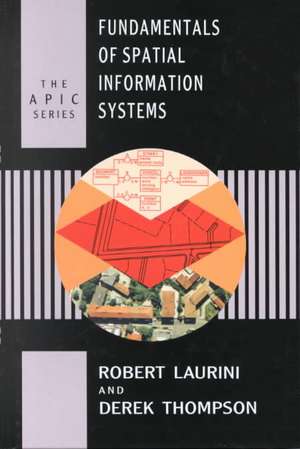Fundamentals of Spatial Information Systems
Autor Robert Laurini, Derek Thompsonen Limba Engleză Hardback – 8 mar 1992
- Serves as the first comprehensive textbook on the field of Spatial Information Systems (also known as Geographic Information Systems)
- Contains extensive illustrations
- Presents numerous detailed examples
Preț: 341.08 lei
Nou
Puncte Express: 512
Preț estimativ în valută:
65.26€ • 68.33$ • 54.00£
65.26€ • 68.33$ • 54.00£
Carte tipărită la comandă
Livrare economică 29 martie-12 aprilie
Preluare comenzi: 021 569.72.76
Specificații
ISBN-13: 9780124383807
ISBN-10: 0124383807
Pagini: 680
Dimensiuni: 152 x 229 x 44 mm
Greutate: 1.06 kg
Editura: ELSEVIER SCIENCE
ISBN-10: 0124383807
Pagini: 680
Dimensiuni: 152 x 229 x 44 mm
Greutate: 1.06 kg
Editura: ELSEVIER SCIENCE
Public țintă
Graduate students and researchers in geography, computer science, scientific computing, and applications in scientific computing.Cuprins
Introduction to the Spatial Context:
Geomatics.
Introduction to Spatial Information Systems.
Needs.
Purposes and Types of Spatial Problem.
Semantics.
Objects, Surfaces, Data.
Geometries For Spatial Data:
Geometries.
Position, Representation, Dimensions.
Topology.
Graphs, Areas, Ordering.
Tessellations.
Regular and Irregular Cells, Hierarchies.
Manipulations.
Interpolations, Geometric Operations, Transformations.
Spatial Analysis.
Attribute Data, Modelling, Integration.
Conceptual Modelling for Spatial Data:
Design for Information Systems.
Methodologies, Issues.
Spaghetti: Conceptual Modelling of Line-Oriented Objects.
Pizza: Conceptual Modelling for Areas and Volumes.
Spatial Object Modelling.
Views, Integration, Complexities.
Spatial Data Retrieval and Reasoning:
Algebras.
Relational and Peano Tuple.
Spatial Queries.
Types, Algorithms.
Access and Quality: Spatial Indices and Integrity Constraints.
Hypermedia.
Multimedia Spatial Information Systems and Hypermaps.
Spatial Knowledge.
Intelligent Spatial Information Systems.
Afterword.
Index.
Geomatics.
Introduction to Spatial Information Systems.
Needs.
Purposes and Types of Spatial Problem.
Semantics.
Objects, Surfaces, Data.
Geometries For Spatial Data:
Geometries.
Position, Representation, Dimensions.
Topology.
Graphs, Areas, Ordering.
Tessellations.
Regular and Irregular Cells, Hierarchies.
Manipulations.
Interpolations, Geometric Operations, Transformations.
Spatial Analysis.
Attribute Data, Modelling, Integration.
Conceptual Modelling for Spatial Data:
Design for Information Systems.
Methodologies, Issues.
Spaghetti: Conceptual Modelling of Line-Oriented Objects.
Pizza: Conceptual Modelling for Areas and Volumes.
Spatial Object Modelling.
Views, Integration, Complexities.
Spatial Data Retrieval and Reasoning:
Algebras.
Relational and Peano Tuple.
Spatial Queries.
Types, Algorithms.
Access and Quality: Spatial Indices and Integrity Constraints.
Hypermedia.
Multimedia Spatial Information Systems and Hypermaps.
Spatial Knowledge.
Intelligent Spatial Information Systems.
Afterword.
Index.
Recenzii
"It is...the first serious attempt to write a GIS text that has some substantial computer science in it.... an exciting new treatment of the computer science of GIS." --Michael Goodchild, NATIONAL CENTER FOR GEOGRAPHIC INFORMATION AND ANALYSIS
"I think this is a remarkable book, and the two very different personalities have combined to produce a very cohesive piece of work. This book presents a detailed and comprehensive discussion of the technical and theoretical aspects of spatial information. It ranges widely over important themes such as the nature and sources of spatial information, spatial referencing and modelling. This book should be essential reading for all those involved in teaching, research and development in spatial information systems. It is a comprehensive course book for all those who take Masters or Doctoral research in GIS, and should become a standard graduate-level text." --Michael Blakemore, NATIONAL ONLINE MANPOWER INFORMATION SYSTEM, United Kingdom
"I am impressed with the approach... the combination of the backgrounds of the authors--a geographer and a computer scientist--has worked to produce a book with a distinct 'modern' perspective." --Andrew U. Frank, NATIONAL CENTER FOR GEOGRAPHIC INFORMATION AND ANALYSIS
"A real service to the field... The book is rich with examples, many supported by the large number of clear--and clearly labeled--tables, diagrams, and other graphics; these illustrations...will be especially useful in teaching or explaining the topics covered... It should be especially attractive to students and others new to this growing field who will find it provides a thorough introduction to the underlying concepts." --Jack Dangerod, President, ENVIRONMENTAL SYSTEMS RESEARCH INSTITUTE, Inc. (ESRI)
"I think this is a remarkable book, and the two very different personalities have combined to produce a very cohesive piece of work. This book presents a detailed and comprehensive discussion of the technical and theoretical aspects of spatial information. It ranges widely over important themes such as the nature and sources of spatial information, spatial referencing and modelling. This book should be essential reading for all those involved in teaching, research and development in spatial information systems. It is a comprehensive course book for all those who take Masters or Doctoral research in GIS, and should become a standard graduate-level text." --Michael Blakemore, NATIONAL ONLINE MANPOWER INFORMATION SYSTEM, United Kingdom
"I am impressed with the approach... the combination of the backgrounds of the authors--a geographer and a computer scientist--has worked to produce a book with a distinct 'modern' perspective." --Andrew U. Frank, NATIONAL CENTER FOR GEOGRAPHIC INFORMATION AND ANALYSIS
"A real service to the field... The book is rich with examples, many supported by the large number of clear--and clearly labeled--tables, diagrams, and other graphics; these illustrations...will be especially useful in teaching or explaining the topics covered... It should be especially attractive to students and others new to this growing field who will find it provides a thorough introduction to the underlying concepts." --Jack Dangerod, President, ENVIRONMENTAL SYSTEMS RESEARCH INSTITUTE, Inc. (ESRI)


